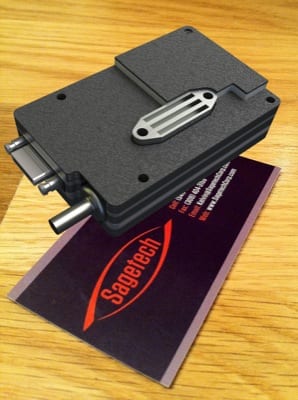It’s the size of a business card. Weighing less than a cell phone, it’s the world’s smallest aviation transponder — and it’s on board Kansas State University’s unmanned aircraft vehicle.
The XPS-TR transponder was developed by Sagetech Corp., Hood River, Ore., and has shattered size records with a footprint smaller than that of a standard business card. K-State’s unmanned aircraft program is the first to use the transponder,according to university officials, who note the transponder was recently installed in K-State’s Aerosonde Mark 4.7.
Virtually all aircraft carry transponders to transmit an active reply to air traffic control interrogations. The replies, known as squawk codes, provide flight plan information like the aircraft call sign and aircraft type, which improve an air traffic controller’s picture of the airspace sector. The Sagetech transponder is special because it can fit easily on small unmanned aircraft.
 K-State uses the Aerosonde Mark 4.7, produced by AAI Corporation, as a general-purpose research platform. Weighing about 50 pounds and not much larger than a Canada goose, the unmanned vehicle is invisible to air traffic control primary radar. Though stealthy radar invisibility can be a benefit during covert military operations, the inability of air traffic control to monitor unmanned aircraft locations presents a significant barrier for civilian missions in the national air space, university officials note.
K-State uses the Aerosonde Mark 4.7, produced by AAI Corporation, as a general-purpose research platform. Weighing about 50 pounds and not much larger than a Canada goose, the unmanned vehicle is invisible to air traffic control primary radar. Though stealthy radar invisibility can be a benefit during covert military operations, the inability of air traffic control to monitor unmanned aircraft locations presents a significant barrier for civilian missions in the national air space, university officials note.
“Adding a transponder to the unmanned platform is a step toward eliminating that barrier,” said Kurt Barnhart, head of the department of aviation and director of the Applied Aviation Research Center at K-State.
Sagetech’s XPS-TR transponder includes automatic dependent surveillance-broadcast (ADS-B) in and out capability, which allows the unmanned aircraft vehicle operator to electronically see surrounding aircraft, greatly improving situational awareness. This means the transponder also can transmit the aircraft’s altitude, identification, selected heading and much more. Barnhart said this is ideal where size, weight and power are at a premium, such as with small unmanned aircraft. The transponder’s small size and weight create more fuel and payload carrying capacity, providing greater flight endurance and mission capability.
“Sagetech’s products are plug-and-play compatible with the Cloud Cap autopilot system that we use to control our Aerosonde. We’re especially excited about the automatic dependent surveillance-broadcast in and out capability that will offer a paradigm shift in our ability to integrate into the national airspace system,” said Josh Brungardt, director of K-State’s unmanned aircraft systems program office.
For more information: SageTechcorp.com, AAIcorp.com, Salina.K-State.edu
